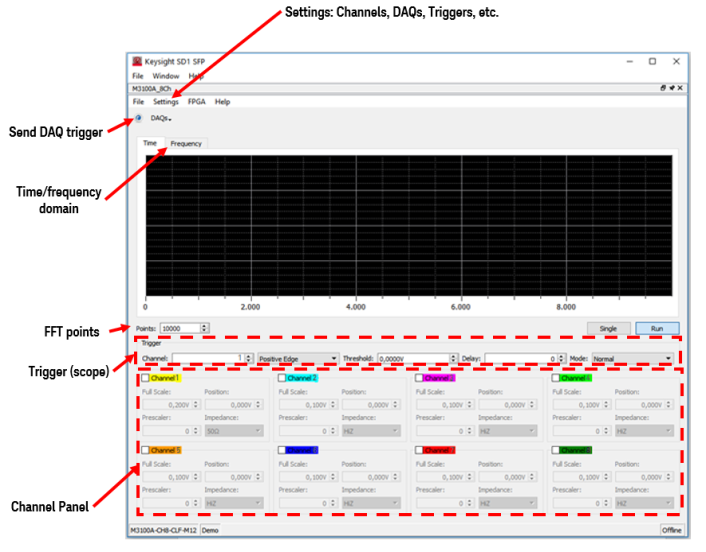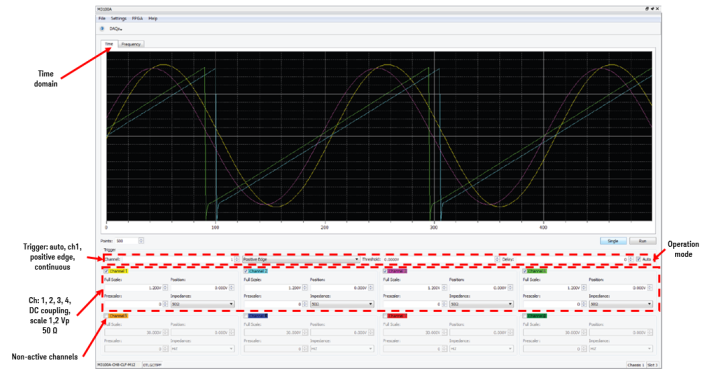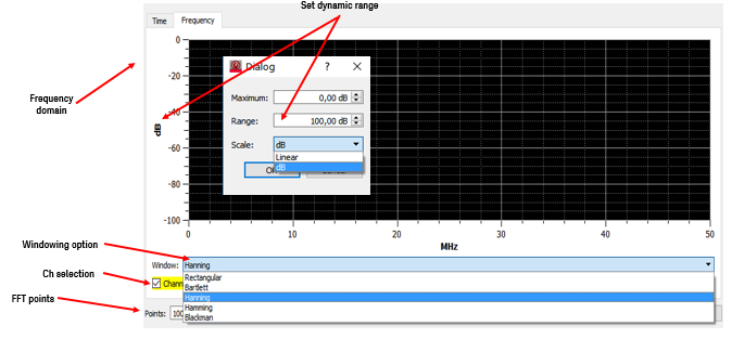
Keysight hardware products can be operated as classical benchtop instruments using Keysight SD1 SFP [2], a software front panel application. This chapter describes the M31/M33XXA digitizer SD1 SFP front panel. Consult Section 3.3.1.
Figure7a shows the M32/M33XXA AWGs SD1 SFP front panel, which appears automatically when SD1 SFP is launched and the module is connected to the chassis. If there are no modules available, SD1 SFP will launch ”Demo Offline” modules

Figure: 7a
When SD1 SFP is launched, the M32/M33XXA digitizers front panel appears populated with all available channels, waiting for the user to configure the input ”Channels”. Digitizer front panel provide both time domain (scope like functionality) and frequency domain (spectrum analyzer like functionality).
Figure7b shows the input controls of the M32/M33XXA digitizers in SD1 SFP.

Figure7b: M31/M33XXA digitizer input control.
Figure7c shows the dialogs and the workflow to use the SD1 SFP as a scope.

Figure7c: M31/M33XXA digitizer scope workflow.
Digitizer scope Workflow:
1. Select channels
2. Define acquisition type (single or run)
3. Set coupling and impedance
4. Define triggering:
- channel (any of the channels)
- edge (positive, negative, both)
- threshold (within fullscale settings of the channel)
- delay
- mode (normal, auto, slave)
Figure7d: shows the tab to configure the Spectrum Analyzer (FFT) options.

Figure7d: M31/M33XXA digitizer FFT (Spectrum analyzer) control.
Spectrum analyzer Workflow:
1. Select channel
2. Define number of FFT points (set resolution)
3. Set windowing option (see windows types below)
4. Set dynamic range:
- scale (Linear or dB)
- set max
- define range
Window is a mathematical function that is zero-valued outside of some chosen interval and it is used in applications including spectral analysis.
Window types used in FFT function (section 2. 2. 7. 33)
| Programming Definitions | |||
|---|---|---|---|
| Option | Description | Name | Value |
| Rectangular | Simplest B-spine window | WINDOW_RECTANGULAR | 0 (default) |
| Bartlett | Hybrid window | WINDOW_BARTLETT | 1 |
| Hanning | Side-lobes roll off about 18 dB per octave | WINDOW_HANNING | 2 |
| Hamming | Optimized to minimize the maximum nearest side lobe | WINDOW_HAMMING | 3 |
| Blackman | Higher-order generalized cosine windows for applications that require windowing by the convolution in the frequency-domain | WINDOW_BLACKMAN | 4 |
| Kaiser | Adjustable window maximizing energy concentration in the main lobe | WINDOW_KAISER | 5 |
| Gauss | Adjustable window (can be used for quadratic interpolation in frequency estimation) | WINDOW_GAUSS | 6 |
Table14a: M31/M33XXA digitizer FFT window types.
As described in FPGA Programming: Keysight M3602A , Keysight’s FPGA design environment allows the user to customize the FPGA code of Keysight M3XXXA PXIe modules with -FP1 option enabled, providing the capability to perform custom Digital Signal Processing onboard in real time. Keysight’s FPGA technology uses Keysight M3602A, an easy-to-use FPGA graphical design environment.
Keysight M3602A provides up to x3 faster FPGA compiling and hot programming without having to reboot the system.

Figure 8: M3602A diagram of the M31/M33XXA Digitizers input channels (all input channels have the same structure)